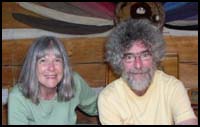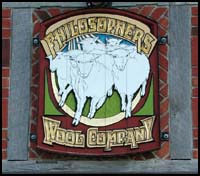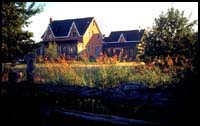 Eugene and Ann |  |  The Farm |
Philosopher’s Wool began in 1986. We started this wool company to improve the price farmers get for their fleece, convinced that if we could pay farmers decently for their fleece, we would be rewarded with high quality fleece. I wanted to produce a yarn that would retain its natural oils while avoiding the chemicals, acids and bleaches that are routinely used when wool is washed. These chemicals dehydrate the fiber and make wool scratchy and itchy. Once the natural wool is dehydrated, moisturizers are added to soften the wool. Unfortunately, these also make people allergic to wool. As a farmer, I was often bemused at how soft the fleece is on the sheep, yet how harsh it is when made into a sweater. Because I work outdoors, I thought the natural oils would help to keep the wool water-resistant. The washing mill I used suggested that it would be a mistake to try to retain as much of the oils as possible since this would also leave excessive amounts of dirt, stains and vegetable matter in the wool. They encouraged me to carbonize the fleece to help eliminate the vegetable matter. To carbonize the wool, however, I would also have to bleach it to strip it of its natural oils. My wool wasn’t dirty or full of vegetable matter. I know that a lot of wool is, but I felt that farmers had simply become discouraged. It costs us about $.70/lb. to shear the sheep. When we get between $.10-.30/lb. for the fleece it’s obvious that there is no financial incentive to farmers to produce clean fleece. $.30/lb. isn’t much for fleece, but it’s not a bad price for dirt, chaff and water. I got $.30/lb. for my fleece that was clean; so did the farmer who sold dirty fleece.
Philosopher’s Wool would change this. I’d read that during the American Civil War, farmers were paid $US2.00/lb. for fleece. If farmers could be paid that then, they could be paid that today. I devised a method of payment to farmers that pays them on a yield basis for their fleece: the cleaner their wool, the more they would be paid to a maximum of $3.70/lb. for a 100% yield. That yield, of course, is impossible to achieve. Average yields on North American wools, where our climate is damp, tends to be in the 35-45% range. This would result in payments to farmers of about $1.50/lb. for very average wools. That’s a very good price for average wools, but we weren’t interested in average wools. By working with shearers, we have managed to increase our yields to between 60-65% for an average payment to farmers of about $2.35/lb. last year. I make an initial payment to farmers of $.75/lb. when the wool is delivered to me. When I have that wool processed into yarn, I can determine precisely what the finished yield has been, and I make a profit-share payment to those farmers that precisely reflects this yield. This process can take approximately 2-3 years from the time I originally buy the fleece, but farmers have been well rewarded for their wait.
So have our customers. Our yarns are strong, produced primarily by down-type sheep. These wools are ideal for outdoor fair isle and aran style sweaters. Our colours range from undyed natural white and natural greys produced by coloured sheep to a range of dyed colours that allow us to reflect the colours of the world in our sweater designs. Our colour combinations autumn, fire, peacock, woodland directly reflect the natural world. Others, such as Kool Aid, barbequed, ocean spray, reflect our imagined and romanticized view of the world. The graphics design allow for random colouring with the range of colours we’ve developed and selected for our various kits, or direct you in the use of those colours, if that’s what you’d prefer. Our patterns never call for more than two colours per row so that knitters are free to play with colour instead of untangling balls of wool. We have two weights of wool, a 2-ply worsted weight that knits one-colour on 4mm, and two-colour on 5mm needles; and a 3-ply chunky that knits on 5.5mm and 6.5mm needles for one- and two-colour work. Because the natural oils have not been scoured out of the yarn it softens your hands as you knit. We have our yarns spun and dyed at a variety of mills throughout Canada and the United States. This gives us an uneven yarn palette that allows our fairisles to be somewhat textured and gives our sweaters a very home-spun look. The patterns are written for circular needles so that finishing is more the pleasure of shaping the sweater’s final touches than endlessly darning ends. We recommend that those who knit with our wool start with the sleeves: you learn the graph and determine your colour work on a small piece of the sweater. If you want to make changes, it is not very difficult or time-consuming. As well, in knitting the sleeves, you discover whether the garment feels the way you want it to feel. If it does, you have a perfect tension swatch for your knitting. By adding the number of stitches, you have over 4 inches in 5 different places on the two sleeves, you will have captured your average tension for this pattern and these yarns. Dividing by 20 yields the average stitches per inch. Multiplying by the desired chest size (we recommend bust plus 8-10″ for women and chest plus 6-8″ for men) tells you exactly how many stitches are needed just above the ribbing. You see which pattern size has the closest number of stitches and knit that pattern size for a sweater that is sure to fit.
Eugene Bourgeois